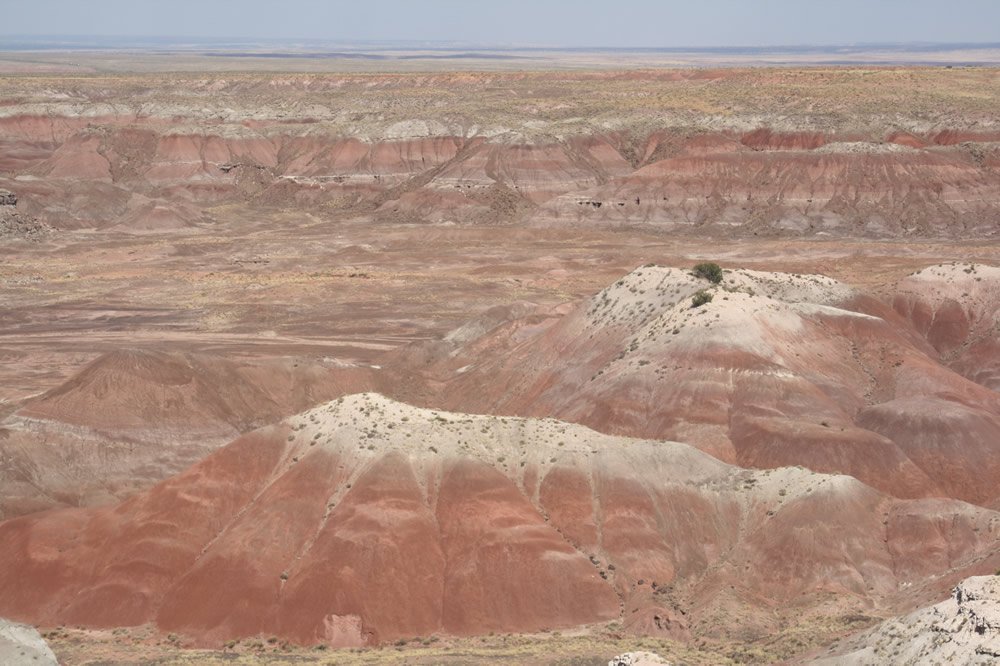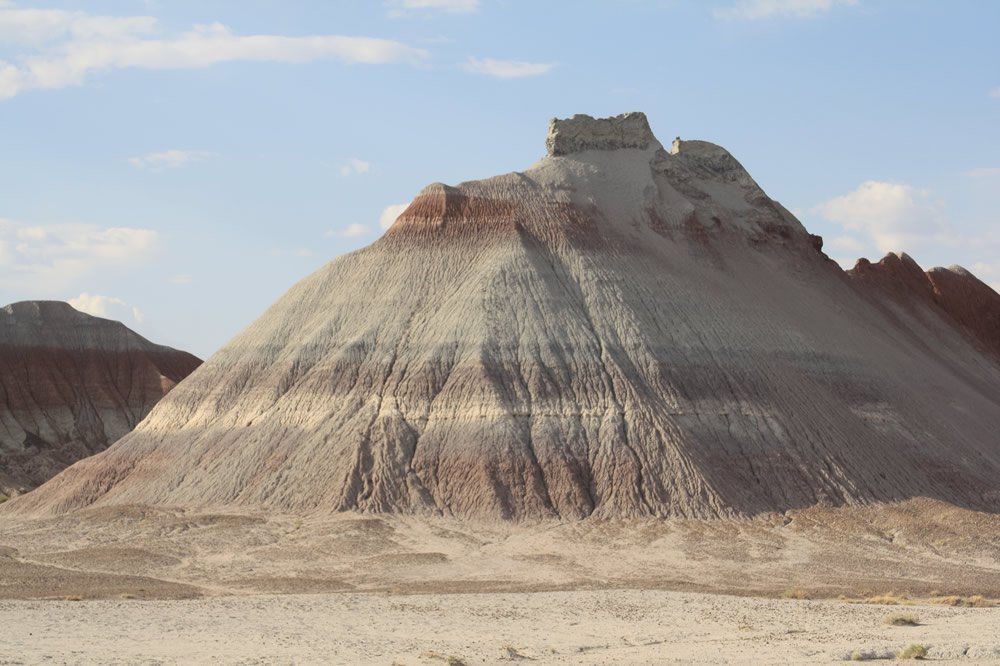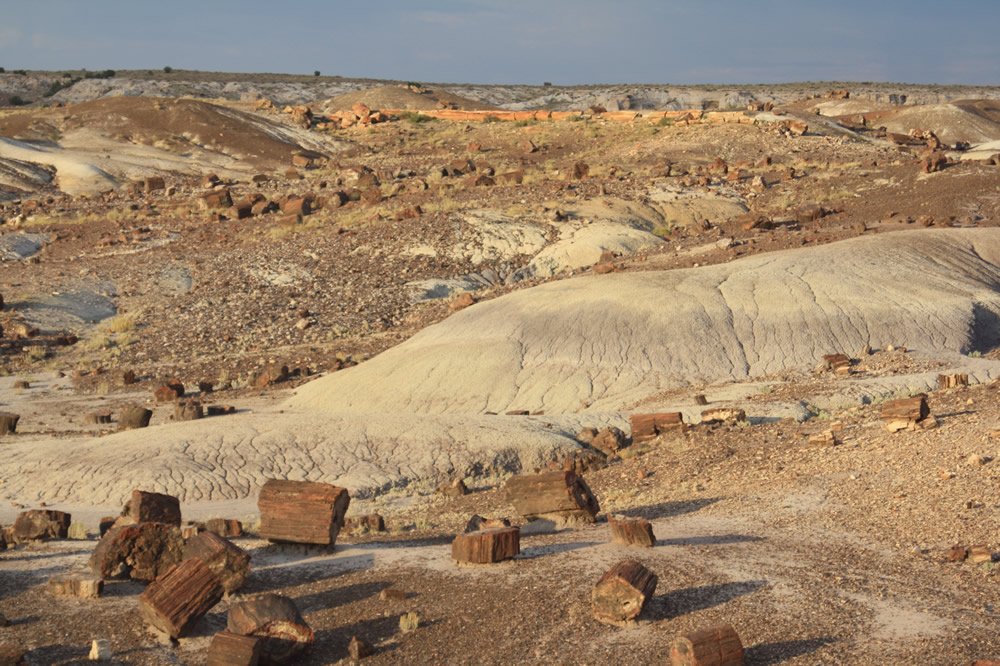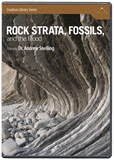
Dearth of Dinosaurs in Late Triassic Tropics Not Due to Raging Wildfires
News to Know
Abstract
Chinle Formation records disaster, but not millions of years of climate change.
- Sci-News.com: “Why Early Dinosaurs Were Small and Rare in Tropics”
- University of Utah: “Why Big Dinosaurs Steered Clear of the Tropics”
- Fox News: “Mystery Solved: Why Large Dinosaurs Avoided the Tropics for Millions of Years”
If we could board a time machine and zip back to the time that New Mexico’s fossil rich Chinle Formation was deposited, would we discover why dinosaurs are sparse in tropical latitudes in the Late Triassic? Scientists conducting an analysis of the fossils and rocks there believe they have in essence done so, solving a persistent paleontological mystery. Would the clock in our time ship tell us we’d gone back 205–215 million years . . . or only about 4,350 years? Would we look out our window and see—as scientists now claim—wildfires raging, destroying the plants on which long-necked, plant-eating dinosaurs would have depended, thus explaining their absence? Or would we see a chaotic view of volcanic eruptions and surging sediment-laden water washing over hundreds of thousands of square miles and dumping the remains of countless animals and plants in the places where many of them would one day be found stacked in layers of fossil-rich rock?
Dinosaur Mystery Solved?
Paleontologists have long wondered why dinosaurs are scarce in the Late Triassic rock layers of the presumed tropics of that supposed time. Fossilized dinosaurs appear abundantly in those rock layers in today’s higher latitudes. In fact, though long-necked herbivorous dinosaurs are virtually absent in the Late Triassic’s supposed tropics, fossils of other reptiles and mammals are plentiful. A team of scientists recently sought the answer to this mystery at Ghost Ranch, home of New Mexico’s Chinle Formation, particularly its Petrified Forest Member, which hosts the petrified logs in the nearby Petrified Forest National Park. (Dinosaurs, primarily carnivorous ones, accounted for only 15% of the vertebrate fossils they sampled in the region.1) Ghost Ranch was made famous by 20th century artist Georgia O’Keefe. Views from Ghost Ranch inspired many of her most famous landscapes.2



These photographs show the Petrified Forest Member of the Chinle Formation in the Petrified National Park. The first is the view from the Painted Desert Overlook. The second is an erosion remnant known as a “tepee.” The third shows petrified logs in the “Crystal Forest.” Images courtesy of Dr. Andrew Snelling.
There at Ghost Ranch researchers analyzed petrified wood and charcoal, carbon and oxygen isotopes in organic debris and carbonate nodules, and the fossilized animals, plants, and pollen grains. By correlating all the data, the authors of the study published in Proceedings of the National Academy of Sciences believe they have reconstructed a picture of the conditions in the region 205 to 215 million years ago. “Each dataset complements the others, and they all point towards similar conditions,” lead author Jessica Whiteside says. “I think this is one of the major strengths of our study.”3 By piecing together from the raw data what they deem to be an accurate picture of a drought-ridden, wildfire-ravaged region that was located close to the equator long ago, the authors of the study believe they’ve solved the mystery. But have they?
Monument to Disaster
The Chinle Formation is a huge fossil-rich region of alternating mudstones and sandstones and some conglomerates. Answers in Genesis geologist Dr. Andrew Snelling explains,
The Chinle Formation has at its base the Shinarump Conglomerate Member, a layer of conglomerate averaging 50 feet thick covering an area of more than 100,000 square miles. Deposition of rounded cobbles, boulders, and pebbles in a sand matrix over such a large area requires catastrophic deposition.
What kind of catastrophe could have deposited all that material over such a huge region? We know of no comparable event happening today, so the present is not the key to the past. We must therefore either deduce how these geologic layers came to be in light of the historical record—God’s eyewitness account in the Bible—or else assume, as this group of scientists has done, that the layers accumulated over millions of years.
Observations and Interpretations
The scientists studying the region are studying these beautiful rock formations and fossils in the present. They have collected a great deal of observable information about the mudstones, the fossilized pollen grains, plants and animals buried in them there, and the charcoal and carbonate nodules in these rock units. They catalogued the kinds of pollen, plants, and animals preserved in these rock layers. They obtained reflectance measurements on pieces of charcoal and isotopic ratios on carbonate nodules. But that is where the observable data in their study ends. The rest of the study consists of interpretation, extrapolating from the observable, testable data to the unobservable, untestable past. Such interpretation, Dr. Snelling points out, depends on the scientists’ starting assumptions:
To arrive at their interpretations the authors assumed the sedimentary layers and the fossils in them took millions of years to be deposited. So in their interpretation the fossils represent animals and plants that lived in environments at the location of these rock units and died there to be buried there. The pollen, wood, and charcoal represent to them plants that grew there. The charcoal they interpret as the result of wildfires, whose temperatures of combustion can be interpreted from the wood’s carbon isotopic composition plus the degree of reflectance of the wood fragments. The carbonate nodules are also interpreted as soil nodules, so that their isotopic composition is supposedly a reflection of the environmental conditions, such as the carbon dioxide content of the atmosphere at that time.
Thus there are multiple levels of interpretation all based on interwoven assumptions that all result from the primary assumption that these sedimentary layers took millions of years to be deposited while animals and plants lived and died in that supposed environment.
All their conclusions . . . depend wholly on their belief that the layers were deposited over millions of years and reflect the local environment.
The authors of the study collected a great deal of data. But what did they actually see? All they saw were rock layers containing carbonate nodules and fossils of animals, pollen, and plants, and pieces of wood and charcoal. They measured isotopic compositions and the light reflectance of the charcoal. They identified and inventoried the dead plants and animals buried in those rock layers. They did not, however, see any wildfires. They did not see the flora and fauna living in the region. They did not even see any ancient soil. They did not measure the atmospheric carbon dioxide content of a long ago place. They did not measure the temperatures of wildfires. All their conclusions about the conditions of the place and time that produced these rock layers depend wholly on their belief that the layers were deposited over millions of years and reflect the local environment.
But what if the layers were deposited rapidly? What if much of the materials they studied were actually washed in from other locales by the surging waters of a catastrophic global Flood? Dr. Snelling explains how looking at the same data from a different worldview leads to entirely different conclusions:
There is an equally valid yet superior interpretation of the same repeatable observational and experimental data—rock layers, fossils, nodules and isotopic compositions. But, this interpretation, unlike the uniformitarian/evolutionary millions-of-years interpretation, is based on eyewitness testimony. In a court of law, eyewitness testimony carries conclusive weight that overturns interpretations of forensic scientists who did not observe the action at the original scene.
The alternate interpretation is that these rock units were deposited catastrophically within days during the global Genesis Flood, the eyewitness testimony of which comes from an infallible source who was present and always tells the truth, namely, the all-knowing, ever-present Creator of the universe.
Ecosystems Burned, Churned, and Poured Out
Let’s further consider the composition of the Chinle Formation. As Dr. Snelling explains, the physical evidence indicates the petrified trees preserved in the Chinle Formation did not grow where they were buried but were broken off and stripped and then transported to their final resting place:
Throughout the Chinle Formation, including the Petrified Forest Member, the mudstones are largely composed of fine-grained decomposed volcanic ash. The petrified logs in this unit don’t have any roots attached to their bases, they have no branches coming off them, and many are oriented and lie in a similar direction. This indicates the trees did not grow where they were buried. They grew elsewhere and were broken off at their bases and stripped of their branches, exactly the same as what happened to the trees in the forests surrounding Mt. St. Helens when it erupted in May 1980.
By comparison with this well-documented modern historical event we can infer that the trees in the Chinle Formation were blasted by huge volcanic eruptions and then transported rapidly with volcanic ash to be deposited where they are now found. Petrification would have occurred as hot water leached silica from the volcanic ash burying the trees and then permeated the wood’s cellular structure so that the silica was deposited therein.
This alternate scenario of catastrophic volcanic eruptions and water transport and deposition, Dr. Snelling explains, leads to a completely different set of conclusions when used to interpret the observational data gathered by these scientists:
The mudstones and sandstones with occasional conglomerates were deposited by water on a very large regional scale. The fossils were buried rapidly in these sedimentary layers. The order of the fossils is the order of their burial, not the order in which the animals and plants lived, because they all lived at the same time just before the Flood, surviving until these days during the Flood year. In fact, the animals buried here were those who were caught and carried away by the floodwaters from nearby areas. They likely never lived in those nearby areas, but were just there as they fled to escape the repeatedly surging floodwaters. Therefore they do not necessarily represent the remains of any nearby ecosystem.
The pollen and wood also represent what was carried in the floodwaters and were thus buried in the order in which they were deposited with the sediments. What of the charcoal? The charcoal would represent pieces of wood from branches burnt by the volcanic eruptions, and their interpreted combustion temperatures reflect volcanic eruptions that showered the original trees.
The carbonate nodules would have formed in situ after deposition of the sediments, but their isotopic compositions would represent the surrounding conditions in the hardening host sedimentary rocks, not those in soils of ancient ecosystems. And since the sediments accumulated while huge violent volcanic eruptions were occurring nearby, the isotopic compositions would reflect the carbon dioxide trapped in the sediments from the volcanic eruptions and from the combustion of the wood.
Conditions Revealed
The petrified trees and fossil assemblages . . . are a snapshot of plants and animals that were swept together by the chaotic conditions of volcanism and raging water over a few days during the global Flood.
Thus the conditions mirrored in the mass of data from the Chinle Formation do not reflect millions of years of wildfires, drought, and global warming. Instead they represent the transitory conditions existing during the few days in which the sediments that now comprise those beautiful rocks catastrophically accumulated. They therefore tell us nothing about how climate change affected Late Triassic ecosystems. The petrified trees and fossil assemblages there do not reflect ancient ecosystems that existed for millions of years but are a snapshot of plants and animals that were swept together by the chaotic conditions of volcanism and raging water over a few days during the global Flood.
When we consider the enormous power of the Flood that swept away the world that Noah had lived in and remodeled the Earth’s surface, we should remember the reason God unleashed that judgment. God originally made a perfectly good world for man. When Adam and Eve rebelled against God they brought the curse of suffering and death down upon the whole world. The rebellion of mankind against God continued and worsened. Indeed, one of the most moving scenes in John Milton’s allegorical account of biblical history, Paradise Lost, involves Adam looking into the future to see the disastrous mess his descendants would make of this world. God’s Word tells us that before the Flood, “The Lord saw that the wickedness of man was great in the earth, and that every intent of the thoughts of his heart was only evil continually
” (Genesis 6:5). Yet by God’s grace there was a way of escape during the Flood for those who trusted God—Noah’s family. And God from the beginning likewise planned a way of salvation available through repentance and faith in His Son Jesus Christ. When we look at the Chinle Formation and Georgia O’Keefe’s famous renditions of it,4 we should remember the violent judgment that built it and the beauty of the salvation available to us through God’s grace.
Further Reading
- Basic Geology Disproves Creationism?
- Deceitful or Distinguishable Terms—Historical and Observational Science
- Doesn’t the Order of Fossils in the Rock Record Favor Long Ages?
- Order in the Fossil Record
For More Information: Get Answers
Remember, if you see a news story that might merit some attention, let us know about it! (Note: if the story originates from the Associated Press, FOX News, MSNBC, the New York Times, or another major national media outlet, we will most likely have already heard about it.) And thanks to all of our readers who have submitted great news tips to us. If you didn’t catch all the latest News to Know, why not take a look to see what you’ve missed?
(Please note that links will take you directly to the source. Answers in Genesis is not responsible for content on the websites to which we refer. For more information, please see our Privacy Policy.)
Footnotes
- J. Whiteside et al., “Extreme Ecosystem Instability Suppressed Tropical Dinosaur Dominance for 30 Million Years,” Proceedings of the National Academy of Sciences 112, no. 26 (June 30, 2015): 7909–7913, doi/10.1073/pnas.1505252112.
- Of the Cerro Pedernal, a New Mexico mesa viewed from Ghost Ranch, O’Keefe said, “It’s my private mountain. It belongs to me. God told me if I painted it enough, I could have it.” She died in 1986, and her ashes were scattered there.
- “Why Big Dinosaurs Steered Clear of the Tropics,” University of Utah, June 15, 2015, http://unews.utah.edu/news_releases/dinosaur-mystery-explained/.
- For example, “My Backyard,” http://www.wikiart.org/en/georgia-o-keeffe#supersized-landscape-231739 (purchased by the Cincinnati Art Museum in 2013).
Recommended Resources

Answers in Genesis is an apologetics ministry, dedicated to helping Christians defend their faith and proclaim the good news of Jesus Christ.
- Customer Service 800.778.3390
- © 2024 Answers in Genesis





